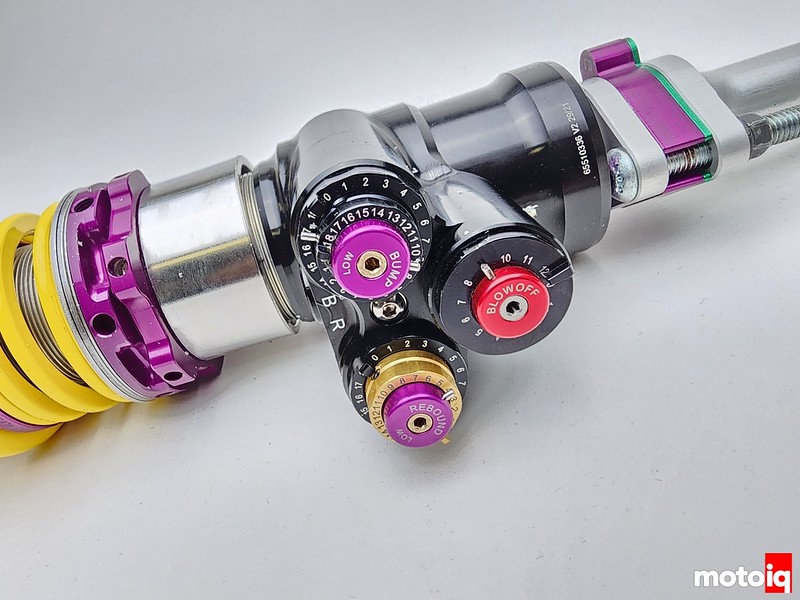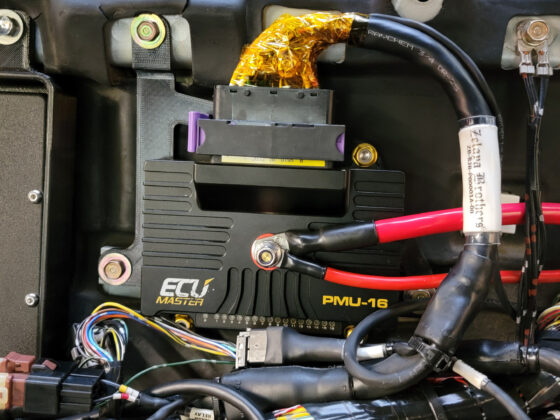
This is what the typical high-speed rebound adjustment range is. We find that high-speed rebound adjustment is very useful when changing to higher-rated springs. Stiffer springs have more bounce in the high-speed range and this adjustment is just the thing to take care of that.

The 4-way motorsports shocks have coaxial knobs for low and high speed. Since high spring rates for high downforce cars require a lot of damping force and a lot of preload the EXR valve pack can get stiff to turn so for these applications KW has the option of using an Allen wrench and a pin spanner tool to turn the knobs easier as shown here.

The King of the Motorsports shocks are the V6, 5-way adjustable. The 5th adjustment is a very high-speed blow-off. Typically at very high shaft speeds like a curb hit, you turn up the high-speed compression to keep the car from crashing through the travel. In a car with a lot of aero load, the forces can get pretty high and the high speed can continue to climb and the car will stop responding to bump loads. Penske has a regressive damping piston to help with this but KW does one better, you can adjust the very high-speed bleed so you can run a lot of initial high-speed damping but the shock can have an extra high-speed blow-off to handle bumps with very high loading. I haven’t gotten to work with these shocks yet but I would like to try them on a car like the Evasive S2K.

Here is the typical adjustment range of the high-speed blow-off. As you can see it only comes into play at very high piston velocities.
So how do you adjust shocks with a lot of knobs without messing things up? If you follow these basic steps you will be ok. First, you can set your shocks to full soft on all adjustments or if you have experience softer than what you ever plan to use. KW and ST Suspension also have really good baseline settings for all of their products in the enclosed instructions.
We have gone through this in all of our other articles on the subject so I won’t go into as deep detail here. You always start on the compression side first and try to run the highest compression settings and the lowest rebound settings to get the job done.




9 comments
“KW and ST Suspension also have really good baseline settings for all of their products in the enclosed instructions.”
I did email KW a couple months ago, to ask what were the default settings on my KW v3’s, and the response wasn’t that, but rather to just start at full soft and work your way up +2, until it’s too stiff, then back off -2 or -1. No defaults were listed in the manual that I could find. In fact, I found the manual of theirs rather lacking. I ended up crowd sourcing some settings, started there, and ended up with something that is 90% there to my liking… I just need more time behind the wheel now to fine tune.
That being said, thank you thus far for the excellent content on this topic and each part you’ve created. Super valuable.
Next article could be on re-valves or choosing spring rates, why you want them, and how it relates to road or track performance. e.g. I recall reading examples of “abnormally,” high spring rates that would hurt you back, but with proper valving, was perfect to match the driving profile of the car.
The reality is that on the street, you’re not tuning for a time, you’re tuning for a driver and a road.
If you have crappy roads, and an older driver, you are going to go softer.
If you have smooth roads and a younger driver you can crank up the stiffness.
One thing I will say, is chuck the sway bar on your driven wheels and do roll control through the damper/spring. Its going to really suck up the bumps that way. I think super stiff sway bars are the work of the devil.
You can also find that stuff online on their website. Usually asking people on forums, etc is less than satisfactory. What I think is odd is that OEMs think 10% more spring is a lot, I mean we can go 100% or more stiffer, and with the right stuff, it can sometimes ride pretty nicely, even on the street. I sometimes am reluctant to write about some stuff that I develop. It’s what makes me valuable and it’s stuff I have figured out. I don’t mind writing about standard best practices in racing though.
Hi Mike,
Thanks for the information as always. Just one question and this might be a little off topic but when you tune your suspension bump , ride height and droop do you disconnect the swaybar? I have seen somewhere where they disconnect the sway bar when tuning and getting the measurements on these things but I can’t make sense of the fact why you have to disconnect it when you ran it on track with it on. If you can enlighten me on this please that would be great. Thank you so much.
No., only for corner weighting.
I really do appreciate these guides; I understand there’s a lot of nuance and tricks but for talking about your bread and butter it’s great that you’re giving good useful information other than “well more than one clicker and you need a data system” or “I’d be happy to help for my hourly fee”
On the second to last and last pages, I notice you had some histograms built in Motec’s software and then others in Excel – do you have any other data analysis software packages you prefer, or do you just have some macros and workflows in Excel? I tend to live in Excel for data acquisition analysis on my day job, but I can easily see how there’s, at least in theory, faster and smoother ways to do things.
Actually it’s not excel, its AIM race studio 3. Motec seems to be less glitchy. AIM always had tons of updates and patches and stuff not working.
Oh, I see why I assumed Excel… OK thank you.
actually race studio 2